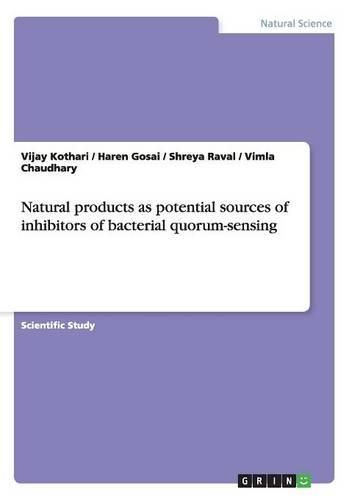Readings Newsletter
Become a Readings Member to make your shopping experience even easier.
Sign in or sign up for free!
You’re not far away from qualifying for FREE standard shipping within Australia
You’ve qualified for FREE standard shipping within Australia
The cart is loading…






Scientific Study from the year 2014 in the subject Biology - Micro- and Molecular Biology, grade: A, Nirma University (Institute of Science), course: M.Sc., language: English, abstract: Objective: To investigate the effect of (i) seed extracts of Pongamia pinnata, Pyrus pyrifolia, and Manilkara hexandra, (ii) bacterial pigment prodigiosin, and (iii) three organic solvents (ethanol, methanol, and DMSO), on quorum sensing (QS) in Chromobacterium violaceum. Methods: C. violaceum was challenged with plant extracts prepared by microwave assisted extraction (MAE) method, prodigiosin, and organic solvents. Effect of these test substances on C. violaceum growth, and quorum sensing regulated pigment (violacein) production was studied by broth dilution assay. High performance liquid chromatography (HPLC) was also applied to generate chromatographic fingerprint of the active extracts. Effect of sub-MIC level of the antibiotic streptomycin on quorum sensing regulated pigment production was also studied. Results: P. pinnata seed extracts and prodigiosin were found to possess anti-QS, and M. hexandra and P. pyrifolia seed extracts to possess QS-enhancing effect in C. violaceum. DMSO was found to enhance violacein production, whereas ethanol and methanol reduced violacein production in C. violaceum. Streptomycin at sub-MIC level was able to significantly arrest QS-regulated pigment production in C. violaceum and S. marcescens. Conclusion: Prodigiosin and the seed extracts used in this study could affect quorum sensing in C. violaceum to a notable extent. Results of this study also emphasizes the importance of inclusion of appropriate solvent controls (negative controls) in bioassays designed for screening of antimicrobial and/or anti-QS compounds. Antipathogenic potential of low concentrations of streptomycin was also demonstrated.
$9.00 standard shipping within Australia
FREE standard shipping within Australia for orders over $100.00
Express & International shipping calculated at checkout
Scientific Study from the year 2014 in the subject Biology - Micro- and Molecular Biology, grade: A, Nirma University (Institute of Science), course: M.Sc., language: English, abstract: Objective: To investigate the effect of (i) seed extracts of Pongamia pinnata, Pyrus pyrifolia, and Manilkara hexandra, (ii) bacterial pigment prodigiosin, and (iii) three organic solvents (ethanol, methanol, and DMSO), on quorum sensing (QS) in Chromobacterium violaceum. Methods: C. violaceum was challenged with plant extracts prepared by microwave assisted extraction (MAE) method, prodigiosin, and organic solvents. Effect of these test substances on C. violaceum growth, and quorum sensing regulated pigment (violacein) production was studied by broth dilution assay. High performance liquid chromatography (HPLC) was also applied to generate chromatographic fingerprint of the active extracts. Effect of sub-MIC level of the antibiotic streptomycin on quorum sensing regulated pigment production was also studied. Results: P. pinnata seed extracts and prodigiosin were found to possess anti-QS, and M. hexandra and P. pyrifolia seed extracts to possess QS-enhancing effect in C. violaceum. DMSO was found to enhance violacein production, whereas ethanol and methanol reduced violacein production in C. violaceum. Streptomycin at sub-MIC level was able to significantly arrest QS-regulated pigment production in C. violaceum and S. marcescens. Conclusion: Prodigiosin and the seed extracts used in this study could affect quorum sensing in C. violaceum to a notable extent. Results of this study also emphasizes the importance of inclusion of appropriate solvent controls (negative controls) in bioassays designed for screening of antimicrobial and/or anti-QS compounds. Antipathogenic potential of low concentrations of streptomycin was also demonstrated.